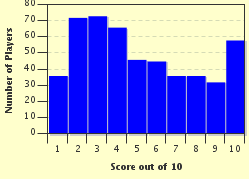Quiz Answer Key and Fun Facts
1. In a right triangle, the sine (usually abbreviated to sin) of an angle is the ratio between the lengths of the side opposite the given angle and the hypotenuse of the triangle. What is sin(90°) plus the smallest angle (in degrees) whose sine is 0.5?
2. A Pythagorean triple is a set of 3 positive integers that can be the side lengths of a triangle (according to the formula a^2+b^2=c^2). For example, 11, 60, 61 is a Pythagorean triple since 11^2+60^2=61^2. What is the sum of the two smallest numbers that are in at least one Pythagorean triple?
3. A perfect number is defined as a number whose positive factors (including itself) add up to twice its value. What is the first perfect number plus the number of factors it has?
4. A prime number is a positive number having exactly two positive factors - itself and 1. What is the second prime number plus the fourth prime number?
5. Euclid is better known as the father of geometry, the study of shapes and space. Regarding the cube, what is its dimension plus the number of vertices it has?
6. Though we use a decimal numeral system, which uses 10 one-digit numbers, others do exist, such as hexadecimal, which uses 16 one-digit numbers. The amount of one-digit numbers a system uses is known as its base (not related to logarithms!), so decimal would be base 10. Even if the base of a system is not known, it can often be determined from the system's name. What is the sum of the bases of ternary and octal, two other systems?
7. In numeral systems with bases that are relatively small but still greater than 10, the alphabet is used for digits representing numbers 10 or greater. For example, base 12 would count like 0, 1, 2, 3, 4, 5, 6, 7, 8, 9, A, B, 10. So seeing A + B is not necessarily extremely odd. What is A + B in hexadecimal (your answer should be hexadecimal as well)?
8. If you've ever played a game of chance, you probably know of probability, the chance of an event occurring. I roll two dice and add their outcome to get a number 'n'. What is the most likely value of n plus the reciprocal of the probability that I obtain that number?
9. One question that calculus answers is how to calculate the instantaneous slope at any point on a curve. This can be done using an equation that models a graph's slope called a derivative. What is the coefficient plus the degree in the derivative of y=x^4?
10. The logarithm (abbreviated log) of a number is the exponent you must apply to a constant (denoted as the base) to get the original number. For example, the log of 25 (base 5) is 2, meaning 25 = 5^2. When a base is not specified, it is usually assumed to be 10. What is log(0.1) plus log(100)?
Source: Author
romon1
This quiz was reviewed by FunTrivia editor
WesleyCrusher before going online.
Any errors found in FunTrivia content are routinely corrected through our feedback system.

